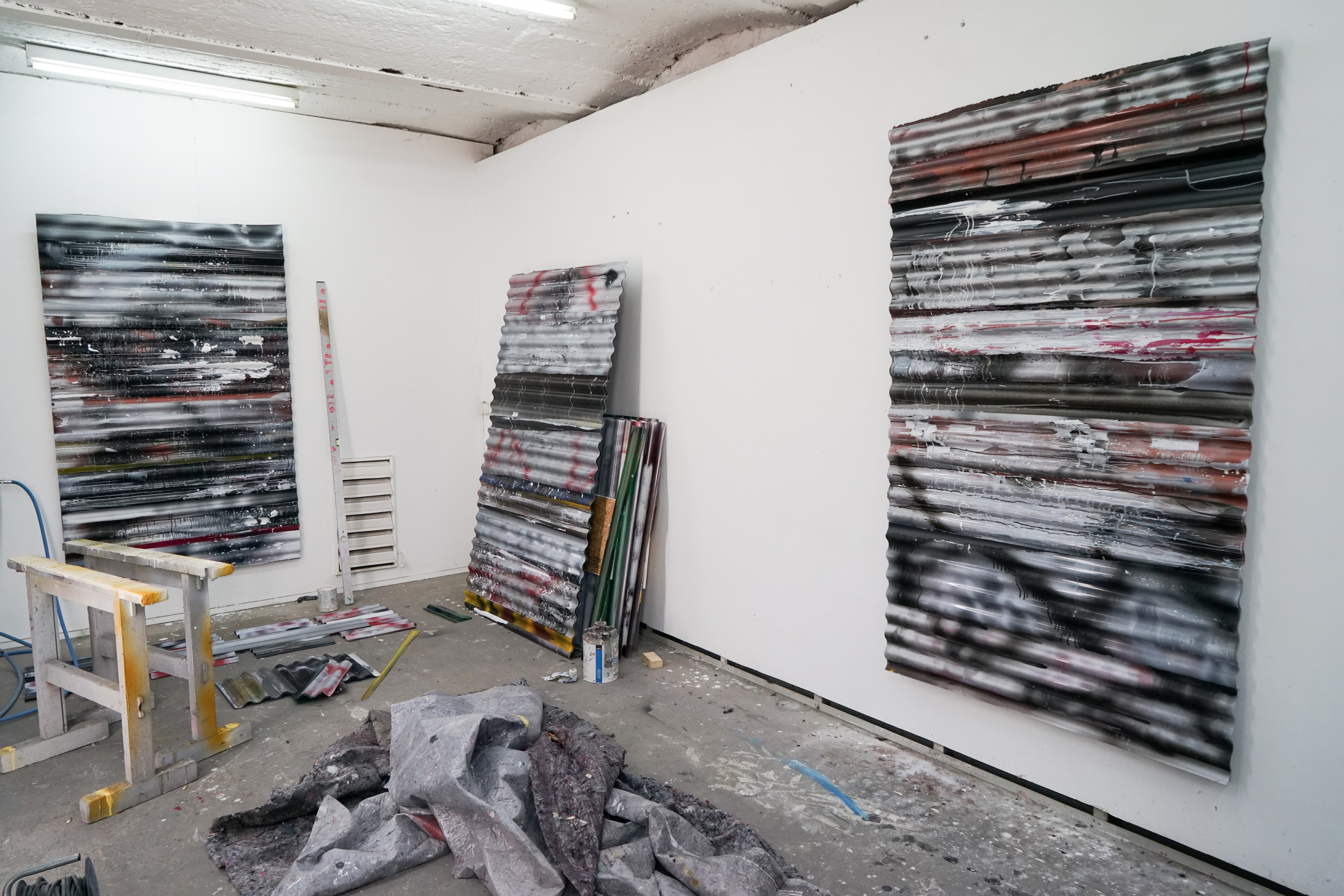Q&A Nils Bleibtreu
Q: Tell me about your background?
I was born and raised in the Ruhr area. My mother’s parents ran a pub in Dortmund. On my father’s side, my family is rooted in the coal and steel industry. While my grandfather still worked the coal seams underground, his son preferred the offce of a steel company. Both of them were pigeon breeders, of course. After school, I, too, worked for Thyssen-Krupp in the fnishing shop, but when my face started to resemble an eighty year old’s, I decided to choose the side of the cooks.
Q: Do you remember the frst artwork you made, and can you tell me about it?
Following scenario: a cadmium red-and-white traffc cone stands on a green plane in front of a prussian blue background, on which the perfect amount of white specks is dispersed. No colour had mixed with the other, and yet this large format, pastose oil painting had an extremely painterly gesture. I sat in my studio for weeks and did nothing else but look at it.
Q: Was there a particular moment or event where you decided to become an artist?
I was seventeen years old and read the love letters between Beckmann and Quappi.
Q: What infuences you? And are there any special artists that you feel inspired by?
Just before I started studying Fine Arts, I fnished reading the Scandinavian Misanthropy by Matias Faldbakken. Back then I liked how the characters in his trilogy dished out in every imaginable direction, that they did not respect any authority. Initially though, I couldn’t make much out of his visual works, that is, until I realised that they transported the attitude that seemed so very much without alternative to me much more radically and at the same time with much more subtlety. Today, I feel similarly when I move through the Ruhr area by train: Where I, as a teenager, would initially and primarily recognise the subcultural signifers, they are now only one part of the whole thing for me. Now I understand better how the material yet to be found comes to its expression.
Q: The Idea/concept surrounding your work, can you tell us more?
It’s the same old story, if you know somebody who’s pregnant, you see pregnant women everywhere, cognitive bias, something like that. My very own cognitive bias (that – as I’ve implied – had to be nurtured by the qualities of a Black Country) asks again and again for the supposedly banal, imperfect. Oh, and then there are those 2000 years of occidental art history. One shouldn’t forget that, that is: high and low, the MoMA as well as the corner kiosk. My work is a hydra, more Baroque than Minimal.
Q: Can you tell me more about the process in your works?
For my current works I am using plastic plaques that I prime with car paint. Then the frst painterly process takes effect. I follow that until the material is eviscerated. For me, the single plaques need to already work in their wholeness as a dystopian visual world. Only when every one of them has gained its entitlement I start to further destroy them. In that way my paintings become venues in which I go on a rampage until the necessary forms materialise. In this, the methods of sampling and re-arrangement mark the cornerstones of those resonating cavities I want to shout into.
Q: What is most important to you regarding your work?
In a way every work demands its own archaeology. A number of layers of plastic and colour are hidden in the frontal view, they can only be seen at the edges, just as if one were watching the transver- se section of a sediment. And it’s exactly this sediment in which the narratives are encased, in same way in which mineral oil always tells something about the seismosaurus, or the coal about the psilo- phytopsida. Apart from that it’s of course also about the fact that each work takes on its one topography, that it can make eye contact and look back onto the viewer. On top of the sediments must lie a self-conscious confdence.
Q: Can you tell me more about your routines and rituals in your daily practice?
I’m quite a square and totally love routine procedures. Getting up at six a.m., drinking a coffee at the kiosk, taking the dog out for a shit, buying fowers and chocolates for the wife, morning shift, evening shift, feierabend beer. That’s all a pretty good compensation for the fact that the acts of failing and relinquishing control at the spray gun are pivotal elements of my work.
Q: The use of construction materials such as corrugated polyester, how and why did this to life?
Well, the material always participates. Linen, for god’s sake. So I looked for something that is less charged, where another background becomes relevant. Of course this is about fction/non-fction, about fnding a language whose grammar isn’t completely spoiled yet and out of which a distance can be created, a distance to that what it’s continually about, that they like to call a poetical-aesthetical perception. This broad feld, on which the duel is eventually never fought, should be left neither to the German Institute for Standardization nor to those who let it smooth their brushes.
Q: Can you let us in on some of the future projects, works?
The same thing we do every night, …
Read more about Nils Bleibtreu at Sunday-S




